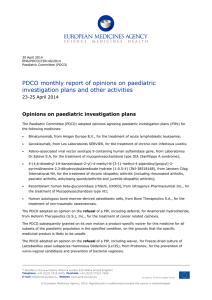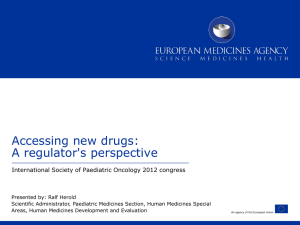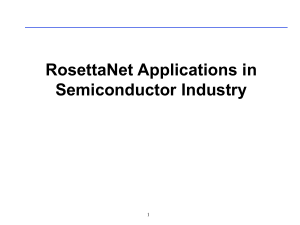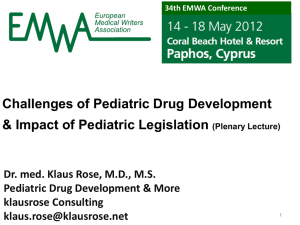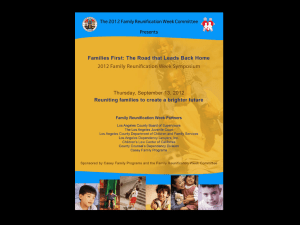Clock
advertisement
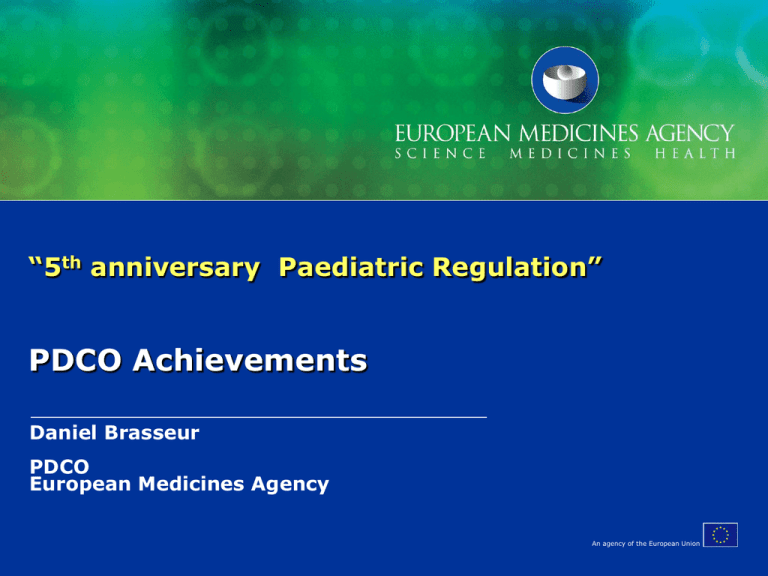
“5th anniversary Paediatric Regulation” PDCO Achievements Daniel Brasseur PDCO European Medicines Agency An agency of the European Union Paediatric Regulation 2 2 Take home message Good research in children is a need & time is needed to develop good research 3 Research Needs in Paediatric Medicines Total Opinions (+&-) 4 700 Research Needs in Paediatric Medicines 5 PIP Opinions (= need) 500 Total Opinions 700 Research Needs in Paediatric Medicines PIP Opinions (= need) 500 Total Opinions 700 70% out of 700 6 7 PDCO Achievements Plan Implementation of procedures PIP Evaluation and Outcomes Survey of the Needs Priority list & FP7 Enprema Challenges 8 Overview of PDCO Procedure Adoption of Opinion, or Adoption of Opinion & Final Report Request for Modification Start Clock 60 DAYS Understand Plan Detect Problems Identify Experts Propose Changes Stop Clock ReStart Clock Opportunity for the Company to introduce Modifications 60 DAYS Decision Evaluate Changes Find Agreement Finalize Plan Publish Decision 9 9 Overview PDCO of Procedure Adoption of Opinion & Final Report Adoption of Opinion, or Request for Modification Start Clock 60 DAYS Understand Plan Detect Problems Identify Experts Propose Changes Stop Clock ReStart Clock Opportunity for the Company to introduce Modifications 60 DAYS Decision Evaluate Changes Find Agreement Finalize Plan Publish Decision 10 10 Overview PDCO of Procedure Adoption of Opinion & Final Report Adoption of Opinion, or Request for Modification Start Clock 60 DAYS Understand Plan Detect Problems Identify Experts Propose Changes Stop Clock ReStart Clock Opportunity for the Company to introduce Modifications 60 DAYS Decision Evaluate Changes Find Agreement Finalize Plan Publish Decision 11 11 12 13 PDCO Achievements Plan Implementation of procedures PIP Evaluation and Outcomes Survey of the Needs Priority list & FP7 Enprema Challenges 14 PDCO 5 CHMP members + 1 members per Member State not yet represented + 6 members from families & HCP associations Each member has an alternate 15 15 16 Poland Portugal Romania Slovenia Spain Sweden The Netherlands United Kingdom Hungary Icelan Ireland Italy Latvia Lithuania Luxembourg Malta Norway Patients' Organisation Austria Belgium Bulgaria Czech Republic Denmark Estonia Finland France Germany Healthcare and Academia Rapporteurships 70 60 50 40 30 20 10 0 PIP Procedure First step = 7 “expert” inputs Rapporteur’s written Contribution Day 20 1st Rapp Oral Present. at PDCO Day 30 1st PDCO Discussion +OE? Day 60 Start Clock Stop Clock EMA Sm Report Day 1 17 Peer Reviewer’s Comments Day 27 Members’ written Comments Day 30-55 Update EMA/ PDCO Report Request for Modification Re-Start Clock PIP Procedure First step = 7 “expert” inputs Rapporteur’s written Contribution Day 20 1st Rapp Oral Present. at PDCO Day 30 1st PDCO Discussion +OE? Day 60 Start Clock Stop Clock EMA Sm Report Day 1 18 Peer Reviewer’s Comments Day 27 Members’ written Comments Day 30-55 Update EMA/ PDCO Report Request for Modification Re-Start Clock PIP Procedure Second step = 9 “expert” inputs OE? Company’s PIP ReSubmission Day 61 EMA Sm Report Update Day 71 2nd Rapp & 2nd PDCO Oral Discussion Present. +OE? Day 90 . 3rd PDCO Discussion Final Report Day 120 PDCO Opinion Re-Start Clock Rapporteur’s Comments on Modifications Day 80 PReviewer’s Comments on Modifications Day 88 Members’ Final Comments to EMA Day 105 Update EMA/PDCO Sm Report Day 110 OE= oral explanation 19 Final EMA Decision Day 130 EMEA Decision 20 20 Evaluation procedure of PIPs PDCO FWG Formulation Group – monthly meeting – PDCO members (Chair: Dr Siri Wang) + external experts (hospital, academia). – Discussion on formulation aspects and reporting to the PDCO. PDCO Paediatric Committee - monthly meeting 21 Applications assessed by FWG PIPs reviewed by Quality Sector Around 1000 PIPs validated PIP/waiver applications 250 220 200 (March 2011) 150 60% 15/m 100 50 No. of PIPs 84 54 0 2008 22 2009 2010-2011 Critical Points for Paediatric Formulations • Route of administration • Appropriate dosage forms • Excipients - 50% of the PIPs- choice excipient, safety, level, side effects…… • Taste and palatability • Delivery devices • Rate of infusion • Volume to be administered • Wastage 23 Regulatory references 2 (Draft) Guideline on pharmaceutical development of medicines for paediatric use 24 • Collaborative work between QWP, PDCO, and external experts. • Public consultation aimed very soon. 25 26 WGroups Non-Clinical Start Clock DAY 0 or 30 Opportunity to discuss need for juvenile animal studies 27 Stop Clock ReStart DAY 60 or 90 Opinion Clock Opportunity to discuss need for juvenile animal studies 28 ay -0 9 ar -0 9 ay -1 0 ar -1 0 ay -1 1 ar -1 1 Ju l-1 1 Se p11 M M Ja n11 No v10 Ju l-1 0 Se p10 M M Ja n10 No v09 Ju l-0 9 Se p09 M M Ja n09 No v08 Number of PIPs discussed NcWG discussions November 2008 - September 2011 25 20 15 Re-discussions New PIPs 10 5 0 WGroups Methodology Start Clock DAY 0 or 30 Opportunity to discuss extrapolations statistics ?modelling 29 Stop Clock ReStart DAY 60 or 90 Opinion Clock Opportunity to discuss extrapolations statistics ?modelling No Reasonable to assume equivalence of disease Children = Adults - similar progression? - similar response to intervention? Yes Yes Reasonable to assume similar concentration response (C-R) in Children = Adults? Conduct PK studies Conduct S & E trials No No Is there a PD measurement that can be used to predict E? Yes Conduct PK studies to achieve levels similar to Adults Conduct S trials Yes Conduct PK/PD studies to get CR for PD measurement Conduct PK to achieve target concentration based on CR Conduct S & E trials 30 Methodological constraints in small populations Overall population Prevalence Affected population Diagnosis Sick population (patients) Project Available Population (volunteers) Participating Population (Cases) CT 31 “Classical Power” Resources Protocol Modelling and Simulation! 32 Definition of Models Published Paradigm PBPK (Physiologically Based PK) PBPK-PD POP PK (Population Based PK) POP PK/PD Disease progression models and response models Kinetic (K)–PD models Toxicity/AE models 33 34 PDCO Achievements Plan Implementation of procedures PIP Evaluation and Outcomes Survey of the Needs Priority list & FP7 Enprema Challenges 35 36 60% 37 38 How many trials have effectively started? How many children to be included? How many indications to be developed? What is the expected product attrition rate? What are finalisation delays overall? 39 6% PDCO Achievements Plan Implementation of procedures PIP Evaluation and Outcomes Survey of the Needs Priority list & FP7 Enprema Challenges 40 REPORT ON THE SURVEY OF ALL PAEDIATRIC USES OF MEDICINAL PRODUCTS IN EUROPE established according to article 42 of Regulation (EC) No 1901/2006 of the European Parliament and of the Council on medicinal products for paediatric use Presented by: Dr. Radu Botgros Scientific Administrator, Safety and Efficacy of Medicines An agency of the European Union Results (I) Most frequent medicines used off-label/ unauthorised: – antiarrhythmics, – antihypertensives (rennin-angiotensin inhibitors and betablockers), – proton pump inhibitors and H2-receptor antagonists, – antiasthmatics, and – antidepressants (mainly selective serotonin reuptake inhibitors, serotonin-norepinephrine reuptake inhibitors and tricyclic antidepressants). High rate of off-label use of oral contraceptives in ados – mainly in Scandinavia. 42 Results (II) Extensive off-label use of ABs in very young children. – macrolides – betalactamines plus betalactamase inhibitors – carbapenems •Corticosteroids used off-label in the systemic treatment of very young children. – Some for systemic use (e.g. dexamethasone) are not even authorised in some countries (Norway) 43 Results (III) Analysis of the pharmaceutical forms • both oral and parenteral formulations are being used unauthorised or off-label, • common reason: lack of appropriate dosages and strengths for the treated age groups. off-label use of – multivitamins – many antiasthmatics. 44 PDCO Achievements Plan Implementation of procedures PIP Evaluation and Outcomes Survey of the Needs Priority list & FP7 Enprema Challenges 45 46 List Applicant’s project DG Research evaluation Funding DG Research EMA PDCO evaluation 47 PIP List Applicant’s project DG Research evaluation Funding DG Research EMA PDCO evaluation 48 PIP List Applicant’s draft PIP PDCO DG Research EMA PIP 49 List PDCO Funding DG Research EMEA PIP Applicant’s project + agreed PIP 50 PDCO Achievements Plan Implementation of procedures PIP Evaluation and Outcomes Survey of the Needs Priority list & FP7 Enprema Challenges 51 Academia Researcher Regulators HCP Industry 52 PDCO Achievements Plan Implementation of procedures PIP Evaluation and Outcomes Survey of the Needs Priority list & FP7 Enprema Challenges 53 Efpia survey on impact of the paediatric regulation on marketing authorization holders (Jan 2007 – Jun 2010) Judith Creba (Novartis Pharma) Craig Johnson (Eli Lilly) Angelika Joos (Merck Sharp & Dome) 23 May 2011 54 EFPIA/EMA Infoday - 23 May 2011 1 34 companies provided input biologicals 55 EFPIA/EMA Infoday - 23 May 2011 6 Timing of Art.7 PIP submissions for new medicinal products (information received on N=146 out of 168 submitted PIPs) 56 EFPIA/EMA Infoday - 23 May 2011 1 Scientific Advice (paediatric only) SA Paed 20 +PA % 15 2007 281 7.5 2008 320 7.2 10 2007 2008 2009 2010 5 2009 388 7.7 FU PA PA ed ed Pa ed Pa Pa 57 Pa SA SA 8 ed 2010 400 FU 0 PDCO Achievements Conclusion Change of mindset with Industry 475 PIPs agreed Start of Network of Networks Limited view of immediate impact… Better overview of Paediatric needs Trials of off-label drugs (FP7) Reflection ongoing to improve/ facilitate work 58 Take home message Good research in children is a need & time is needed to develop good research 59 60
